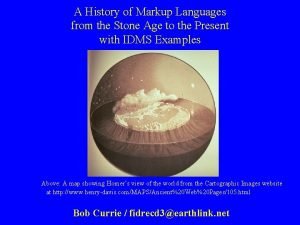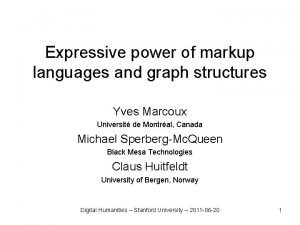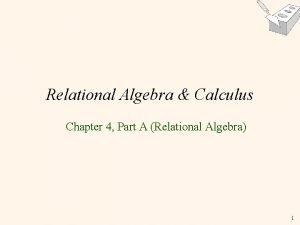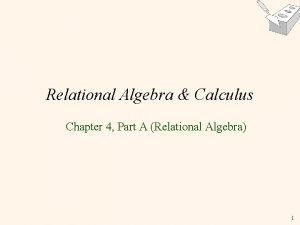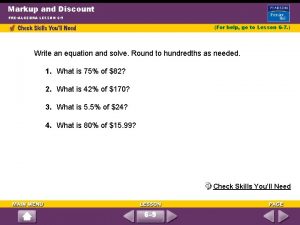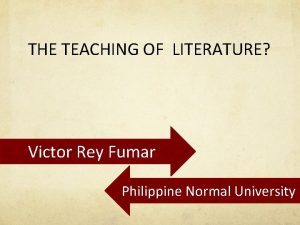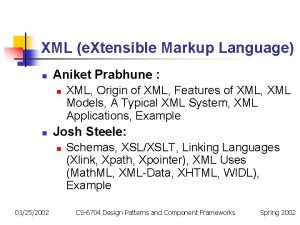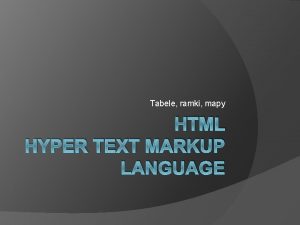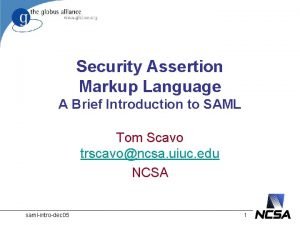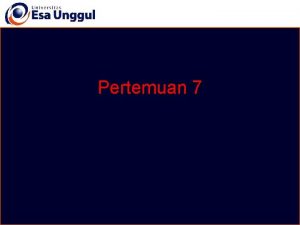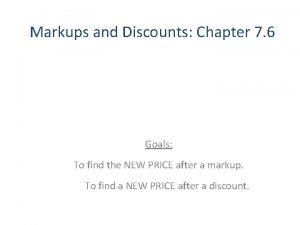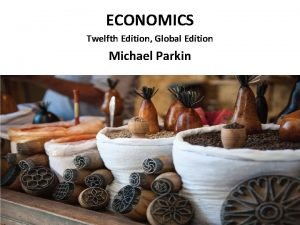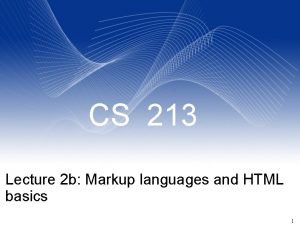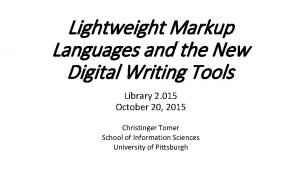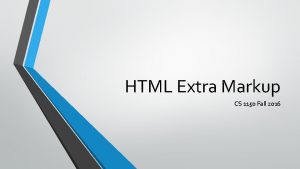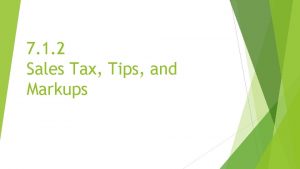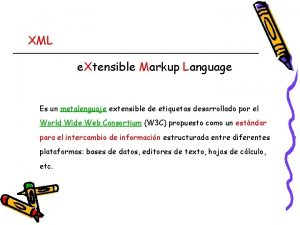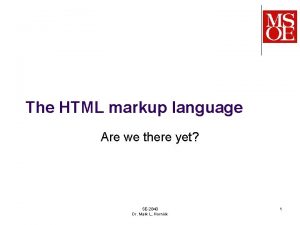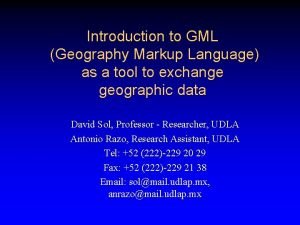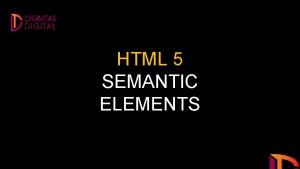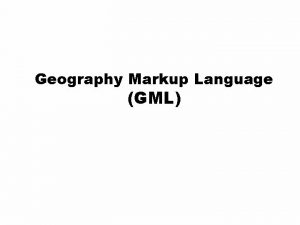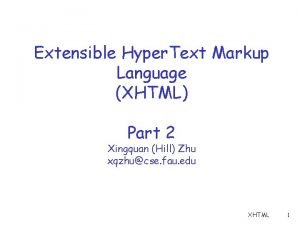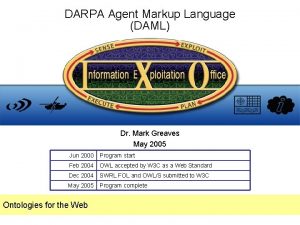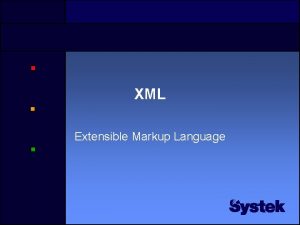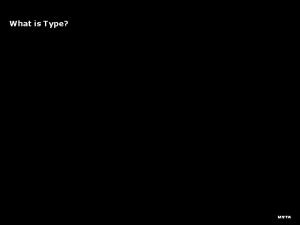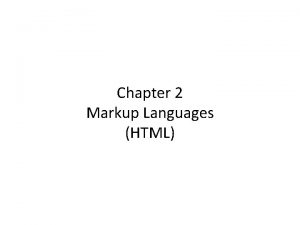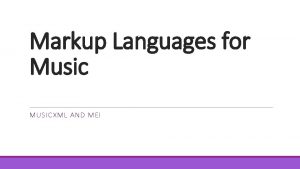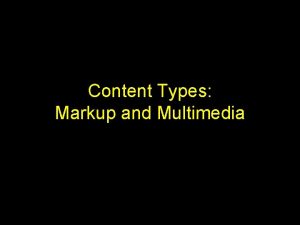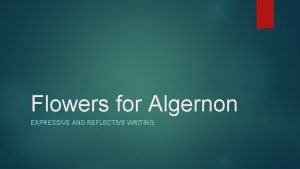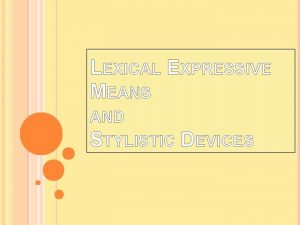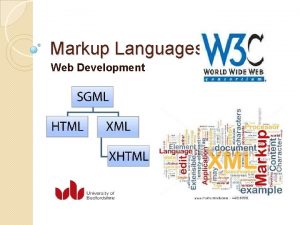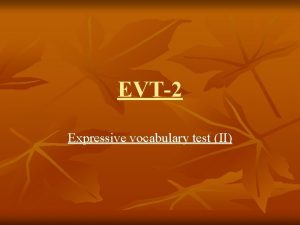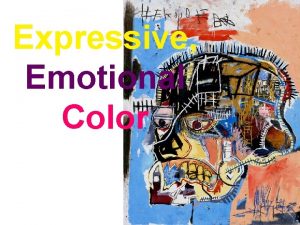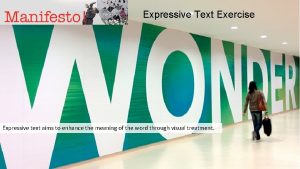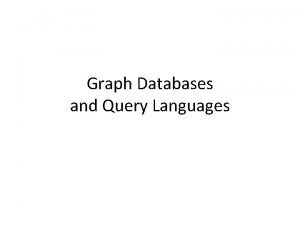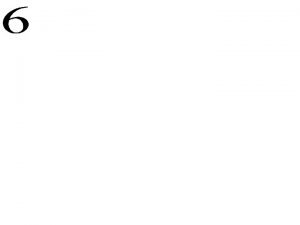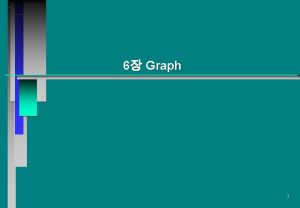Expressive power of markup languages and graph structures


















![Earlier result • In 2008 [M 2008], we identified a particular class of graphs Earlier result • In 2008 [M 2008], we identified a particular class of graphs](https://slidetodoc.com/presentation_image_h/1d213821914365aa23d9a680ef92eade/image-19.jpg)














- Slides: 33

Expressive power of markup languages and graph structures Yves Marcoux Université de Montréal, Canada Michael Sperberg-Mc. Queen Black Mesa Technologies Claus Huitfeldt University of Bergen, Norway Digital Humanities – Stanford University – 2011 -06 -20 1

Overview of the talk 1. Problem setting – – – Graph representations of XML documents Need for more complex structures Overlap-only-Tex. MECS 2. Main result and consequence 3. Future work Digital Humanities – Stanford University – 2011 -06 -20 2

1. Problem setting Digital Humanities – Stanford University – 2011 -06 -20 3

Graph representations of structured documents Digital Humanities – Stanford University – 2011 -06 -20 4

XML document = tree <top> <a> <b/> </a> <c/> </top> top Û a c b Embedding in markup Û Child-parent in tree Digital Humanities – Stanford University – 2011 -06 -20 5

Any tree an XML document <top> <a> <b/> </a> <c/> </top> top Û a c b Digital Humanities – Stanford University – 2011 -06 -20 6

Any tree an XML document <top> <a> <b/> <d><e/></d> </a> <c/> </top> top Û c a b Perfect correspondence ! Digital Humanities – Stanford University – 2011 -06 -20 d e 7

Document Object Models • DOMs are essentially graph representations of structured documents • "Patched" for attributes, namespaces, etc. • DOM manipulations = graph modifications • It suffices to make sure that the graph remains a tree Digital Humanities – Stanford University – 2011 -06 -20 8

Need for more complex structures Digital Humanities – Stanford University – 2011 -06 -20 9

Overlap et al. • In real life (outside of XML documents), information is often not purely hierarchical • Classical examples: – verse structure vs sentence structure – speech structure vs line structure – reordering, discontinuity, etc. • In general: multiple structures applied (at least in part) to same contents Digital Humanities – Stanford University – 2011 -06 -20 10

Example 1 (Peer) Hvorfor bande? (Åse) Tvi, du tør ej!¶ Alt ihob er tøv og tant!¶ vers peer Hvorfor bande? åse Tvi, du tør ej! Alt ihob er tøv og tant! Digital Humanities – Stanford University – 2011 -06 -20 11

Example 2 (last verse spoken in chorus by Peer & Åse) vers peer Hvorfor bande? åse Tvi, du tør ej! Alt ihob er tøv og tant! Digital Humanities – Stanford University – 2011 -06 -20 12

Example 3 (last verse spoken in chorus by Peer & Åse) vers peer Hvorfor bande? åse Tvi, du tør ej! Alt ihob er tøv og tant! Digital Humanities – Stanford University – 2011 -06 -20 13

Example 4 Digital Humanities – Stanford University – 2011 -06 -20 14

OO-Tex. MECS Digital Humanities – Stanford University – 2011 -06 -20 15

Tex. MECS • A particular proposal to address the overlap problem with overlapping markup+ • MECS (Huitfeldt 1992 -1996) – Multi-element code system • Tex. MECS (Huitfeldt & SMc. Q 2003) – "Trivially extended MECS" • Markup Languages for Complex Documents (MLCD) project Digital Humanities – Stanford University – 2011 -06 -20 16

Overlap-only Tex. MECS • Tex. MECS allows overlapping markup. . . • but also much more: – virtual elements, interrupted elements, etc. • OO-Tex. MECS 101 – Start-tags: <a| – End-tags: |a> – Overlapping elements allowed – Natural notion of well-formedness Digital Humanities – Stanford University – 2011 -06 -20 17

OO-Tex. MECS example (Peer) Hvorfor bande? (Åse) Tvi, du tør ej!¶ Alt ihob er tøv og tant!¶ <doc| <vers| <peer|Hvorfor bande? |peer><åse|Tvi, du tør ej! |vers> <vers| Alt ihob er tøv og tant!|åse> |vers> |doc> Digital Humanities – Stanford University – 2011 -06 -20 18
![Earlier result In 2008 M 2008 we identified a particular class of graphs Earlier result • In 2008 [M 2008], we identified a particular class of graphs](https://slidetodoc.com/presentation_image_h/1d213821914365aa23d9a680ef92eade/image-19.jpg)
Earlier result • In 2008 [M 2008], we identified a particular class of graphs that we showed to correspond exactly to OO-Tex. MECS – Those graphs are essentially+ the « restricted GODDAGs » (r-GODDAGs) of [SH 2004] – All trees are r-GODDAGs – Some non-trees are r-GODDAGs too – So: OO-Tex. MECS more expressive than XML Digital Humanities – Stanford University – 2011 -06 -20 19

Example 1 r-GODDAG ? vers peer Hvorfor bande? √ åse Tvi, du tør ej! Alt ihob er tøv og tant! Digital Humanities – Stanford University – 2011 -06 -20 20

Example 2 r-GODDAG ? vers peer Hvorfor bande? åse Tvi, du tør ej! Alt ihob er tøv og tant! Digital Humanities – Stanford University – 2011 -06 -20 21

Example 3 r-GODDAG ? vers peer Hvorfor bande? åse Tvi, du tør ej! Alt ihob er tøv og tant! Digital Humanities – Stanford University – 2011 -06 -20 22

Example 4 r-GODDAG ? Digital Humanities – Stanford University – 2011 -06 -20 23

However… • That kind of result depends on the class of « possible » graphs • Proof used « no. DAGs » (node-ordered) – Already fairly restricted class (though not as much as r-GODDAGs) • Would we get the same result with a larger universe of discourse… – Arbitrary graphs ? Digital Humanities – Stanford University – 2011 -06 -20 24

Example a b "A" "B" <a>A</a><b>B</b> <a>A<b></a>B</b> a "A" b "" Digital Humanities – Stanford University – 2011 -06 -20 "B" 25

2. Main result and consequence Digital Humanities – Stanford University – 2011 -06 -20 26

The result (1/4) • Essentially: r-GODDAGs are really the only graphs you can express with OOTex. MECS Digital Humanities – Stanford University – 2011 -06 -20 27

The result (2/4) • Universe of discourse: CODGs (childordered graphs) – finite, directed graphs, otherwise unrestricted – can have cycles – same child multiple times – many « roots » – can be disconnected Digital Humanities – Stanford University – 2011 -06 -20 28

Example 4 CODG ? Digital Humanities – Stanford University – 2011 -06 -20 √ 29

The result (3/4) • Proof did not carry over • Defining condition for graphs expressible in OO-Tex. MECS did not carry over – completion-acyclic no. DAGs – vs full-completion-acyclic CODGs • But essentially: – completion-acyclic no. DAGs = – full-completion-acyclic CODGS = r-GODDAGs Digital Humanities – Stanford University – 2011 -06 -20 30

The result (4/4) • So, essentially, the graphs expressible in OO-Tex. MECS are: – the completion-acyclic no. DAGs = – the full-completion-acyclic CODGS = – the r-GODDAGs • Consequence: if you need more complex structures than r-GODDAGs, you must extend XML with more than overlap+ Digital Humanities – Stanford University – 2011 -06 -20 31

Future work • Optimal verification algorithm for fullcompletion-acyclicity • Optimal serialization algorithm for fullcompletion-acyclic CODGs • Graphs with partially ordered children • Other constructs of Tex. MECS Digital Humanities – Stanford University – 2011 -06 -20 32

Thank you ! Questions ? <ymarcoux@gmail. com> Digital Humanities – Stanford University – 2011 -06 -20 33
 History of markup language
History of markup language Graph markup language
Graph markup language Expressive power of algebra and calculus
Expressive power of algebra and calculus Expressive power of algebra and calculus
Expressive power of algebra and calculus Homologous structure
Homologous structure Networks and graphs circuits paths and graph structures
Networks and graphs circuits paths and graph structures Power trianlge
Power trianlge Markdown business math
Markdown business math Practice 6-9 markup and discount
Practice 6-9 markup and discount Hyperpoetry examples
Hyperpoetry examples Resource allocation graph and wait for graph
Resource allocation graph and wait for graph Markup language examples
Markup language examples Language
Language Security assertion markup language definition
Security assertion markup language definition Markup price
Markup price Wml adalah
Wml adalah Markups and discounts
Markups and discounts Four firm concentration ratio
Four firm concentration ratio Markup economics
Markup economics Markup language examples
Markup language examples Markup percentage
Markup percentage E language
E language Lightweight markup language
Lightweight markup language Extra markup html
Extra markup html Markup vs discount
Markup vs discount $8.50 yoga mat 75 markup
$8.50 yoga mat 75 markup Language
Language Structural markup html
Structural markup html Geography markup language tutorial
Geography markup language tutorial Non-semantic elements
Non-semantic elements City geography markup language
City geography markup language Td vs th
Td vs th Darpa agent markup language
Darpa agent markup language Xml dokument
Xml dokument
